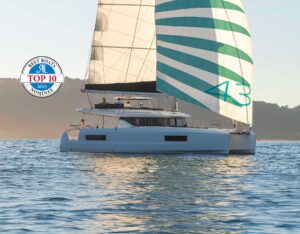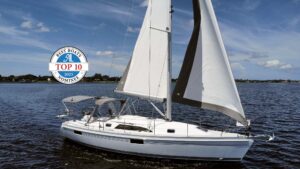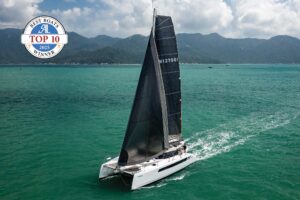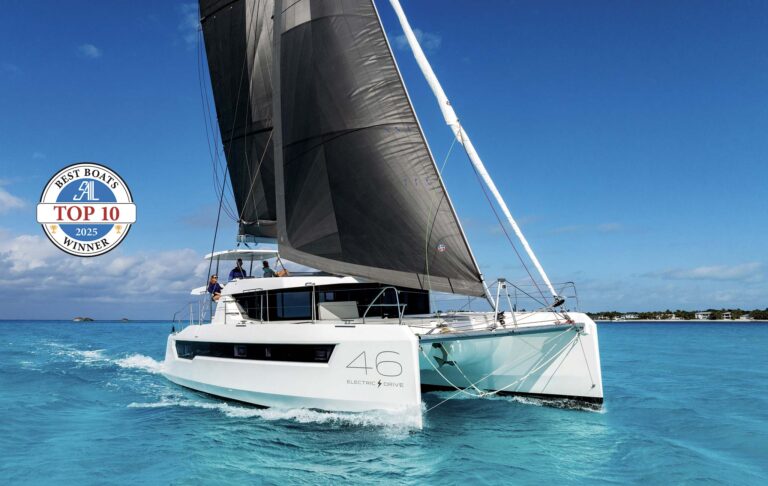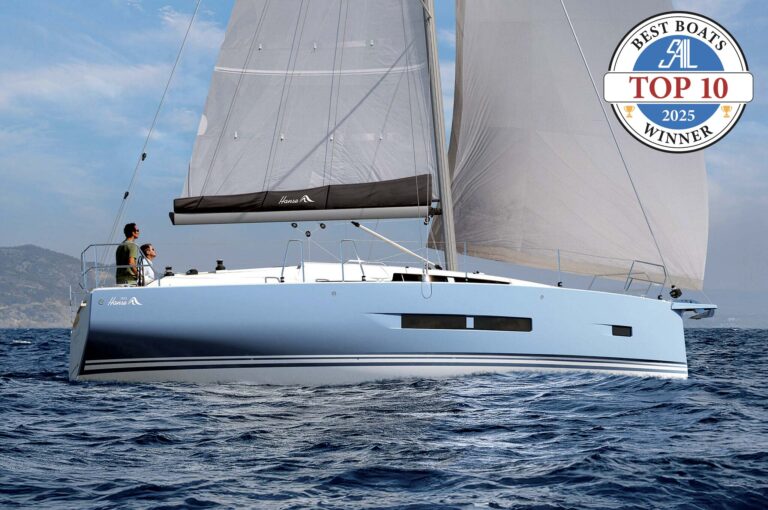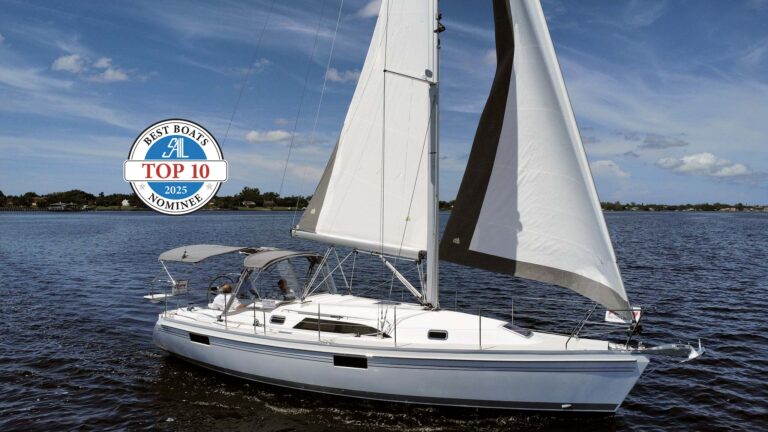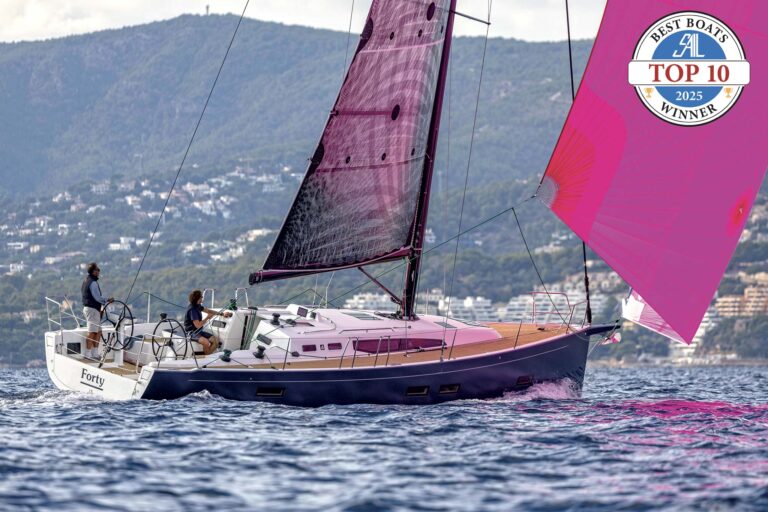We’d left Clearwater that morning and were now headed north, a mile or so off the barrier islands protecting St. Joseph Sound. To me, the obvious way to get closer inshore was via the channel immediately south of Anchor Key. Not only were the soundings a good 8ft or more, but there was a well-marked channel to both Tarpon Springs and the Intracoastal Waterway that we could employ. We were, after all, aboard a new Seaward 46RK, a fully appointed cruising boat, displacing a healthy 23,000lb. To my way of thinking, pressing our luck any further would have been risky, at best.
Nick, however, would have none of that. Instead he had his eye on the gap between Honeymoon Island and Three Rooker Bar—not really a channel at all, but a shallow bit of water where the chart showed soundings of “2” and even “1” smack dab in the middle straddling a symbol for submerged pilings. “Well, it’s your boat,” I thought as he put the helm down and started heading for the aquamarine water ahead.
Sure enough, with every passing boatlength, the bottom came closer and closer until I could clearly make out first our shadow and then the individual ripples in the sand beneath us. Doubling the northern tip of Honeymoon Island, we cut it so close we were inshore of the fisher folk anchored out with their lines in the water. “Amazing!” I thought, as we sidled ever closer to the beach.
Of course, the 46RK is hardly your typical cruiser. With its twin rudders and lifting bulb keel it’s fully capable of swimming in as little as 3ft of water. Nonetheless, it’s one thing to read about that kind of thing on a spec sheet, quite another to see it in practice.
Fast forward 24 hours, and it was my turn to be the tough guy. Nick and I had decided to quit our anchorage and take advantage of the 10 to 15 knot afternoon sea breeze coming off the Gulf of Mexico to do some daysailing. Heading back in with our A-sail up, I was at the helm as we started making our way across the shoal to the northwest of the “channel” between Honeymoon and Three Rooker at 6-plus knots.
Nick was a little anxious. “Tide’s out,” he said, glancing over the side at the patches of grass beneath our keel after the depthsounder checked out when it found there was too little water left to measure. But hey, I thought, the chart said we had all of 3ft of water, so what was the big deal? Amazing how quickly you can get used to this kind of thin-water sailing!
Locals Only
Time was when sailboat design was largely a regional thing, with dozens of different types exhibiting features that made them ideal for a particular sailing area and class of sailors: think scows in the Midwest, or the Cal-40 and ULDB “sleds” created for West Coast sailing and racing.
Today, the consolidation of the boatbuilding industry is such that a far more limited number of designs enjoy much more widespread popularity than in years past. The J/70 daysailer and racer, for example, developed a worldwide following with hundreds of hulls built and sold in what felt like overnight.
That said, there is one design characteristic that remains highly regional to this day, and that’s draft. Much as you might like, say, that nifty little 36ft performance-cruiser with the 7ft-deep bulb keel, all that righting moment is going to put you in a world of hurt if you’re not careful in a place like the Bahamas.
Worse yet, it’s going to deny you access to a whole passel of otherwise gorgeous anchorages due to the simple fact you can’t get into them without hitting the bricks.
Over the centuries, builders and naval architects have done their best to solve this problem by coming up with various means of balancing performance against shoal draft. These include lifting up a boat’s underwater appendages as the water starts to become scarce, and/or creating boats with fixed rudders and keels that are almost vestigial.
The English, for example, faced with the problematic shallows of the Thames estuary, developed flat-bottomed sailing barges with easily raised leeboards, a firm turn of the bilge and plenty of beam to help them stand up to a press of sail. Another popular European solution has been twin, shallow bilge keels, which provide the additional benefit of creating a stable base upon which the hull can rest when drying out at low tide.
Similarly, on the other side of the world, builders across Polynesia and Southeast Asia created an array of different multihulls—catamarans, dozens of different sailing dugouts and various proas—which, in addition to being fast and easy to knock together using simple organic materials, can typically sail in only a couple of feet of water. Think about it: the greatest oceangoing vessel in the world won’t do you much good if you can’t get over that reef and through the shallow lagoon extending a mile or more out from your destination. At the end of a passage, even the most robust ocean-going Polynesian sailing canoe could typically be dragged pretty much up to the beach and tied off to a palm tree.
Finally, here in the United States, the quest for thin-water performance has resulted in some of our most celebrated designs. Examples include New England’s beamy catboats with their centerboards (in larger models) and shallow “barn door” rudders; the equally beamy hard-chined skipjacks of the Chesapeake Bay; and the many different sharpie designs found everywhere from Long Island Sound to the Florida Keys.
And these boat types are not just historic relics. Many contemporary builders continue to launch boats of these same types that would not have looked out of place in the 1800s. Modern production catboat builders include Marshall Marine and the Beetle Boat Shop at the head of Cape Cod’s Buzzard’s Bay and Florida-based Com-Pac Yachts. Similarly, the sharpie concept is alive and well at Florida’s Marine Concepts, builder of the 21ft Sea Pearl, and in countless different home-built boats, including those designed by the late, great Phil Bolger of folding-schooner fame.
Illustrations by Pip Hurn
Make that Change
Since the advent of mass-production boatbuilding in the mid-20th century the quest for shoal-draft has also resulted in various different types of centerboards, daggerboards and kick-up rudders aboard larger and larger boats, including multihulls.
For years, the bulk of these efforts—whether aboard cruisers, performance-cruisers and even all-out raceboats—was focused on centerboards, which pivot around a single point, as opposed to daggerboards, which slide up and down in a fixed slot, such as on a Laser dinghy.
The reasons for this are largely technical. Before the advent of modern composites, a centerboard of any size had to be kept fairly low-aspect with a robust trunk to prevent it from snapping off. Another option was having a much smaller fin rotating in and out of a stub keel for help when sailing on the wind.
If the board was metal—as was typically the case with larger boards—raising and lowering the foil was often quite difficult, given that a manual winch was the only reasonable option for adding mechanical advantage. Obviously, adding any kind of meaningful ballast was impossible, so again, the only real alternative was a smaller board in a ballasted stub. Aboard smaller trailerable boats (in which crew weight, form stability and maybe some water ballast are sufficient to keep you upright) a centerboard also had the advantage of tucking up along the bottom of the hull or in a shallow trunk, where it didn’t impinge on the space belowdecks.
More recently, however, with the advent of advanced electric motors and high-modulus fibers—useful both in the foils themselves and the structures that house them—daggerboard-type foils have come increasingly to the fore, even aboard boats as large as Nick Hake’s.
In the case of the Seward 46RK, the daggerboard, or lifting keel, is comprised of a solid polyester composite, with a fiberglass skin and a series of stainless rods running the length of the foil to both increase stiffness and carry a 7,500lb cast-lead ballast bulb. An electric motor, operated by a set of buttons at the mast, raises and lowers the keel via a high-modulus cable running through a series of blocks to provide additional purchase.
It would be hard to find an easier-to-use system. Underway, we typically sailed with the bulb only part way down, and it can be raised and lowered while underway on nearly any angle of sail, including hard on the wind. The boat is also equipped with twin rudders aft. Both rudders are mounted in a stainless steel cassette, which allows them to be easily raised or lowered and then locked in place.
Not that Hake’s boats (the entire Seaward line features lifting keels) are the only large monohulls employing this kind of technology. Other examples include everything from the previously mentioned J/70 to the Chinese-built Fareast 26 and, increasingly, superyachts like the 220ft Hetairos, which carries a lifting bulb keel that serves to reduce draft from almost 30ft to 11ft when needed. Obviously, it requires some serious engineering to get the Hetairos fin up and down. Aboard smaller boats, however, a much smaller manual ratcheting system is sufficient.
Similarly, many of today’s performance-oriented cruising cats—including those built by Balance, Outremer, Gunboat, Catana and Dazcat—also carry vertically oriented daggerboards. Because of their light weight, these boards can be raised and lowered via a simple pulley system.
In either case, the result is a boat that truly provides the best of all possible worlds, whether it be on the racecourse, on passage or just creeping into a nice cozy anchorage at the end of the day—what more could any sailor ask for than that?
Read Sailing in the Shallows of Florida here
Read Running Aground 101 here
November 2015

